| |
#1 – INCREDIBLE GEOLOGY
| |
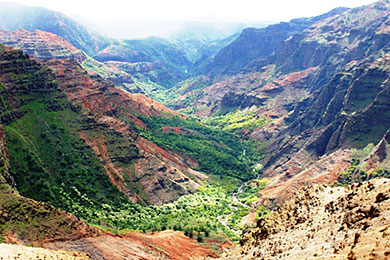 |
|
Created by volcanoes and an enormous fault line, Kauai’s Waimea Canyon was named “Grand Canyon of the Pacific" by Mark Twain. It’s only 14 miles long, two miles wide and over 3,000 feet deep, but on an island that’s only 25 miles long by 33 miles wide. That’s a good chunk of the real estate. This view from Puu Hinahina Lookout. |
|
Plopped in the north Pacific 2,500 miles from the nearest landfall, Hawaii is one of the more remote pieces of real estate on Earth. It is part of the Hawaiian-Emperor seamount chain stretching some 3,600 miles northwest, past Midway to the Meiji Seamount near the western end of the Aleutian Islands. It runs mostly undersea but here and there, 132 reefs, shoals and islands rise above the surface. The “Hawaiian Islands” usually refers to the eight main islands of Kauai, Oahu, Maui, the Island of Hawaii (a.k.a. The Big Island), Niihau, Molokai, Lanai and Kahoolawe. When people think of the“Hawaiin Islands,” it is usually of the first four, the main visitor destinations.
| |
Haleakala’s crater (left) measures 21 miles in circumference and is so rich in iron, it creates its own magnetic field. Sacred to ancient Hawaiians who considered it the center of the earth’s spiritual power, it last erupted in 1790 leaving a massive lava field near La Perouse Bay (right). |
|
Formed by the earth’s crust shifting across a major hot spot, the Hawaiian islands are just babies in comparison to 50-million-year-old Midway. Kauai is just over 5 million years old, Oahu fewer than 3 million, Maui 1.3 million, and the Island of Hawaii not even 500,000 years and still growing daily. About 22 miles off the southeast coast of Hawai’i Island, Loihi Seamount, an active submarine volcano, has achieved a soaring 10,000 feet but it will take another 3,000 feet and 60,000 years before breaking sea level.
#2 – TUMULTUOUS HISTORY
Human contact has been a dubious affair. Uninhabited until the arrival of explorers from the Marquesas perhaps as early as the fourth century, the islands were populated by a wave of immigrants from Tahiti who overran the Marquesans a few hundred years later. Islands were often ruled by multiple kings and they didn’t get along.
| |
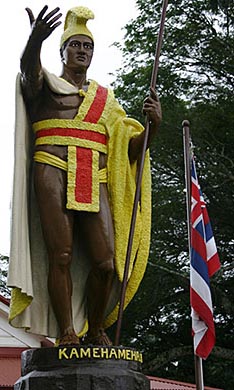 |
|
Created by a sculptor in Boston, cast in Paris and destined for Honolulu, this gilt and bronze statue of King Kamehameha was lost during a shipwreck near Cape Horn in 1883. A replacement casting was finally erected across from Iolani Palace in downtown Honolulu. When Falkland Islanders rescued the original, it was installed in Kapaau in the Kohala region of the Island of Hawaii, where Kamehameha was born. |
|
In 1780, the ruler of the Island of Hawaii named his son as heir and his nephew, Kamehameha, guardian of the god of war. Power-hungry and, according to legend, predestined to be ruler, Kamehameha fought for and won control of the island. Ten years later he defeated the ruler of Maui, and in 1795 Oahu fell in a horrific battle. A peaceful process rather than more bloodshed brought Kauai and Niihau into the Kingdom of Hawaii in the early 1800s.
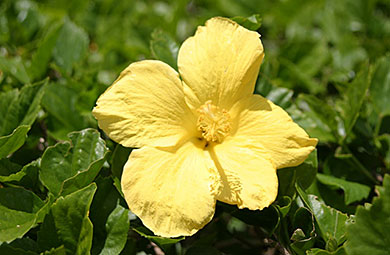
The Yellow Hibiscus is honored with fire trucks painted the color
of
Hawaii’s state flower. The Hawaiians used many plants
for medicinal purposes.
The sap of the hibiscus plant proved effective for constipation and chest congestion.
In 1778 a visitor arrived who would open the islands to the world and bring a tragic downfall to the native population. After charting much of the South Pacific, Captain James Cook stepped ashore on Kauai and promptly renamed the islands in honor of his expedition sponsor, the Earl of Sandwich. The moniker “Sandwich Islands” remained for nearly 70 years. (See European Discovery sidebar)
The following year, Cook dropped anchor off the Island of Hawaii during the annual Makahiki festival, a time when fun and feasting took the place of fuming and feuding. Everyone got along with everyone, even with a boatload of pale-faced strangers who made themselves right at home for weeks of drinking, dancing and enjoying the native women.
Knowing they had overstayed their welcome, Cook departed but was soon forced back to Hawaii repair a broken foremast. Accusations of theft by the Hawaiians and disrespectful and brutal treatment by the English culminated with Cook’s men killing a local chief. While his crew made off in their skiffs, Cook, who could not swim, was stranded on the beach at Kealakekua Bay. A 27-foot obelisk sitting on a tiny parcel of land, officially deeded to Great Britain, marks the place where the Hawaiians took their revenge on their impertinent intruder.
| |
The Noni or Indian Mulberry can do it all. Wounds and fractures benefit from a poultice of ripe fruit and leaves. Leaves and bark treat joint and muscle pain and urinary problems. Immature fruit makes a great tonic for high blood pressure, diabetes and loss of appetite. |
|
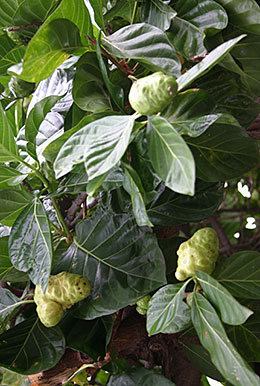 |
|
The Islands were now on everyone’s chart. In the early 1800s whalers began clogging Hawaii’s harbors, as many as 400 ships docked at a time in Lahaina alone. While it was a boon to the economy, debauchery took over seaside towns and diseases such as influenza, measles, whooping cough and syphilis decimated the native population.
In 1823 the first missionaries arrived from New England, and as occurred the length and breadth of the Americas when newcomers arrived to “save” the native inhabitants, they managed to further devastate the population and obliterate the culture. Severely punished if they practiced any part of their culture, some devotees went underground to preserve many of their customs.
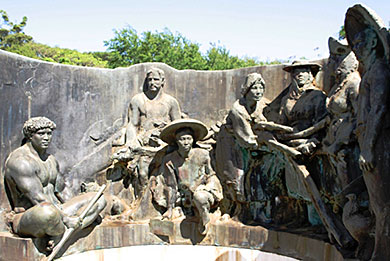
At the Old Sugar Mill of Koloa, the main ethnic groups who were the backbone
of Kauai’s thriving sugar industry (Hawaiian, Japanese, Korean,
Chinese,
Portuguese,
Filipino, Puerto Rican and Caucasian) are forever memorialized in this bronze sculpture.
The islands were becoming a melting pot of people from varied backgrounds and traditions. In the mid-19th century, Hawaii’s population was 97% indigenous. Plantation workers arrived from China to toil in the sugarcane fields. As it became Hawaii’s biggest money-maker, more immigrants came from Korea, Japan, the Philippines and Portugal. By the time the 20th Century rolled around, the native population amounted to a mere 16%. Today, Hawaii is ten times more multiracial than the rest of the U.S.
American businessmen wanted to own and control the land. These values of business-oriented newcomers collided with Hawaiian sensibilities and conflict was inevitable. Native Hawaiians cherished their connection to the land and did not believe it belonged to any one person and continue to feel a deep responsibility to care for the land and sea that nurtured them. In January 1893, without U.S. State approval but with the aid of U.S. Marines, these sugar plantation owners succeeded in overthrowing Queen Liliuokalani, who was a direct descendent of Kamehameha.
The anarchists asked Congress to annex the islands, but after protests were filed it was determined the disposition of the monarchy was illegal. The Republic of Hawaii was formed with a provisional government, officially recognized by Congress. But the following year, after an attempt by her supporters to restore the old Kingdom, the Queen was imprisoned in her own palace for eight months.
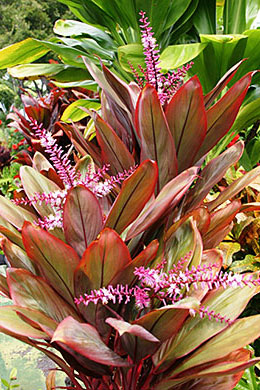
The Ti plant, or Ki in Hawaiian, has a comforting effect on body aches,
headaches and fevers. Its leaves are used to wrap food for cooking while
the dried leaves are made into cloaks, hula skirts, sandals and fish traps.
The root ferments into an alcoholic brew.
In 1897 President McKinley took office and asked Congress to annex Hawaii. The ensuing diplomatic protest, including delegates delivering over 556 pages of signatures, defeated the vote, but the following year the U.S. declared war on Spain and Hawaii was again eyeballed as the perfect base for battles in the Philippines and Guam. McKinley signed the “Newlands Resolution,” Hawaii was seized, and Oahu became headquarters for the American military presence in the Pacific. After suffering through Japan’s invasion of Pearl Harbor, the battle-weary islands were finally awarded statehood in 1959 over the decidedly mixed emotions of its population.
#3 –DISTINCTIVE CULTURE
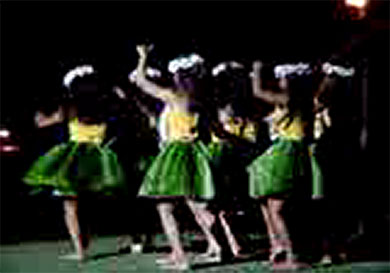
Old Lahaina hula dancers
Hawaiian hula, with its elegant moves, haunting mele (music) and evocative ‘oli (chanting), passed down the history, legends and genealogy of the people and land. Musical instruments were mostly percussion made of gourds and bamboo. When the paniolos, or cowboys, arrived in the 1830s, they brought along their guitars, which eventually evolved into the steel guitar. Paniolos developed the slack key style of playing in which detuning or “slacking” one or more strings produces a soft melody that didn’t startle the cattle they were tending. The ‘ukulele was adopted from a small 4-stringed instrument brought by the Portuguese.
| |
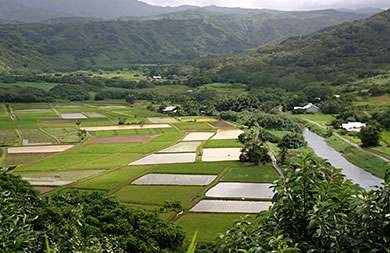 |
|
The Hanalei Valley is famous for its acres of irrigated taro fields, a source of almost half of Hawaii’s poi. Taro root is pounded for a seemingly endless period of time into a paste-like substance of various consistencies, probably most (in)famous of Hawaiian foods. A like-it-or-hate-it sort of fare, if you sample a batch of fresh, sweet poi, you’ll understand the appeal. A staple of Hawaiian life, rootstock rubbed on an injury stops bleeding and raw leaf stock relieves insect bites. Not only is the tuber corm the source for poi, on which babies thrive, it is a remedy for indigestion and constipation. The leaves are used to wrap food for steaming. In Hawaiian mythology, kalo, as taro is spelled in Hawaiian, was believed to be the older brother of mankind. |
|
Music has always been important to Hawaiians and many of them were great composers. The movingly poignant “Aloha Oe” was written by Queen Liliuokalani while imprisoned in her palace. Beyond Don Ho’s “Tiny Bubbles” and Elvis Presley’s “Hawaiian Wedding Song,” another “classic” may have been inspired by Hawaii: “Puff the Magic Dragon” written by Peter Yarrow of the folk group Peter, Paul & Mary.
| |
An oft-repeated legend says the area around Kauai’s north shore inspired the song “Puff the Magic Dragon.” The silhouette west of Hanalei Bay embraces the Wainiha range, backdropped by Makana Peak, and low-lying Kolokolo Point does suggest the humped back of a sleeping dragon, its long neck stretched out and a tuff of taller vegetation at the tip suggesting nostrils. Peter Yarrow spent some time in this part of the island. Is it a coincidence that Puff “lived by the sea” and frolicked in a “land called Honnah Lee” (Hanalei)? |
|
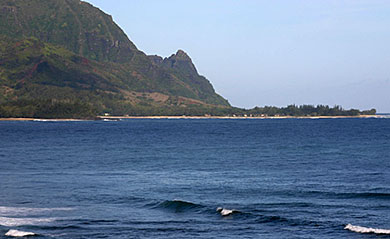 |
|
A multi-cultural populace means a multitude of celebrations. Chinese dragons parade through the streets, folks gather for Japanese bon dances, candle-lit lanterns are set adrift in the Harbor and afloat in the air. Festivals honoring food, film, art and music draw attendees from all over the Islands and mainland. The paniolo way of life is honored with rodeos and parades. The Merrie Monarch Festival, which began in 1963, is undoubtedly the most prestigious hula competition in the world.
The mana or spiritual aura of Hawaii is tangible, emanating from the land and many sacred places, both ancient and contemporary. Hawaiian temples, called heiau, were built for war and for peace, for healing and for sacrifice, and some as places of refuge.
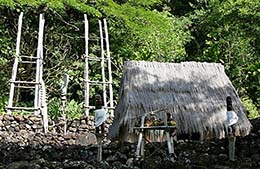 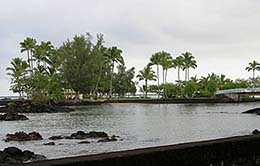 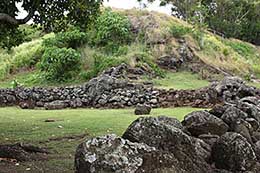
The Hale o Lono Heiau in Waimea Valley, Oahu (left), was dedicated to Lono, god of agriculture and fertility,
music and peace. Coconut Island (center), a small islet in Hilo Bay, served as a place of healing called Moku Ola.
The Holoholoku Heiau, part of the Wailua heiau complex on Kauai, was a royal birthing site.
 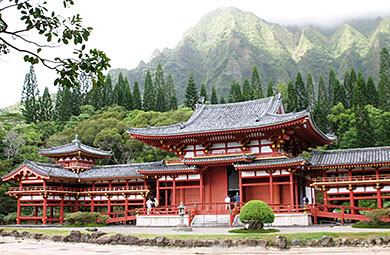
While most of Hawaii’s ethnic groups celebrate their heritage, the Japanese commemorated their arrival with temples
on Maui and Oahu. The Jodo Mission in Lahaina includes a 12-foot copper and bronze Buddha (left),
the largest of its kind outside Japan. In the Valley of the Temples near Kaneohe, the Byodo-In Temple is an
exact reproduction of a 900-year-old Temple near Kyoto. Inside is the largest wood Buddha to be carved
since the original temple was built, its surface decorated with gold leaf.
#4 – IMPLAUSIBLE BEAUTY
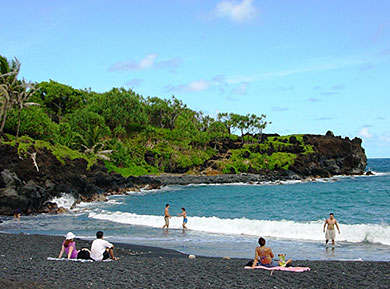 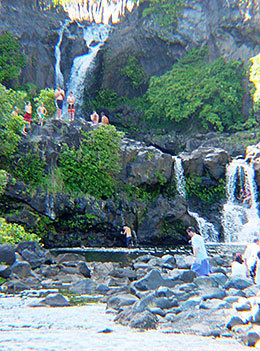
Waianapanapa, a.k.a. Black Sand Beach, near Hana, Maui, is a magnificent example of what time can do
with a volcanic coastline. The 122-acre park includes sea caves, sea arches and half-submerged lava tubes.
The Pools of Oheo, also on Maui, erroneously called the Seven Sacred Pools, are comprised of over two dozen
large and countless small pools formed by waterfalls flowing through a gorge on the slopes of Mt. Haleakala.
Through all the upheavals of nature and man, the islands continued their idyllic routine. Millions of Parrot fish munched and passed coral. Their waste washed ashore to form long stretches of white sandy coastline. Swells heaving across thousands of miles of unobstructed ocean pulverized lava shorelines into black sand coves. The high quantity of iron from the Islands’ volcanic birth created one of the world’s few red sand beaches, Kaihalulu on the Island of Hawaii. Magnesium-rich magma produces olivine, whose tiny crystals color Papakolea beach on the same island, one of only four green sand beaches on our planet. And every one of the more than 385 beaches on just the main islands are public all the way to the high-water line.
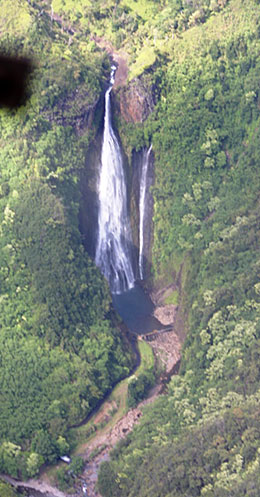 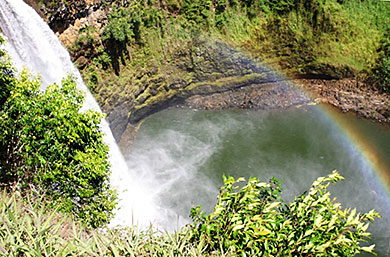
Waterfalls are omnipresent in Hawaii and often gain fame as movie backdrops, including these two on Kauai.
Near the headwaters of the Hanapepe River, Manawaiopuna Falls (left) is also known as “Jurassic Falls”
after serving as the landing site for the helicopter in Jurassic Park. Hawaiian royalty once dove from a cliff
into Wailua Falls (right) but it is most remembered as the opening scene in the television series Fantasy Island.
Lush tropical foliage blankets the slopes of the volcanoes, towering high enough to capture moisture-laden air and feed countless streams and waterfalls - more waterfalls than any other U.S. state. It is not uncommon for Haleakala, just over 10,000 feet, and Mauna Loa and Mauna Kea, both towering nearly 14,000 feet above the surf, to be kissed by snow. Indeed, Mauna Kea was dusted with the white stuff in June of 2015 and 2016. Whenever enough fluff covers the lava fields, a cadre of diehard skiers hike up for a few turns down these volcanic slopes.
#5 – UNIQUE ENDOWMENTS
Measured from their base on the sea floor, 33,476-foot Mauna Kea and 30,085-foot Mauna Loa are the two tallest mountains in the world (Everest measures 29,029 feet). With a sky so clear that 90% of all stars are visible, Mauna Kea is home to the world’s largest concentration of observatories and telescopes, operated by nearly a dozen countries. Haleakala is the largest dormant volcano in the world. The road to its summit is a record-holder for gaining so much elevation in such a small distance.
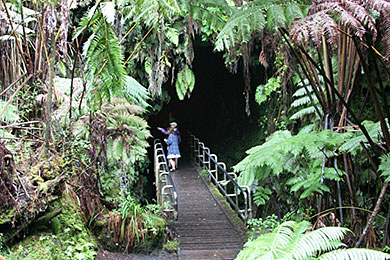 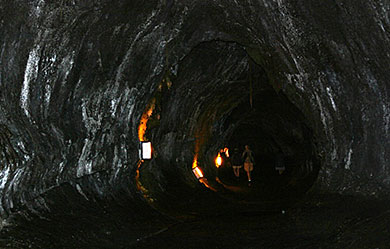
Its entry nearly hidden by vegetation (left), 600-foot-long Thurston Lava Tube is one of the world’s largest.
With ceilings soaring as high as 30 feet (right), it is thought to be about 500 years old. Nearby, Kilauea is the world’s most active volcano and has been erupting continuously since 1983.
The island of Hawaii is home to the world’s deepest, tallest and longest lava tube, the Kazumura Lava Tube System, nearly 41 miles in length. Molokai boasts the tallest sea cliffs in the world, dropping over 3,000 feet.
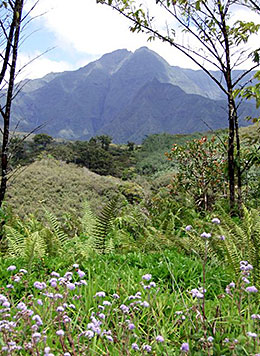
One of the wettest places on earth,
Kauai’s 5,148-foot Mt. Waialeale sees
more than 38 feet of rainfall each year.
Hawaii leads all states in the number of species on the endangered list – nearly 300. Endemic are more than 50 species of birds and 2,500 types of plants. On Kauai, 90% of the flowers are unique to that island. Of the more than 650 species of marine life, 25% are endemic - highest percentage in the world. Oddly, among all of Hawaii’s gorgeous varieties, the Humuhumunukunukuapuaa (a.k.a. Picasso Triggerfish) is not endemic to these waters, but was still made the state fish.
Iolani Palace, constructed in 1882 and the only royal residence on U.S. soil, boasted indoor flushing toilets, telephones and electric lights indoors and out. Every branch of the U.S. military - Air Force, Army, Navy, Marines and Coast Guard - has a base on Oahu. The first high school west of the Rockies opened on Maui in 1831.
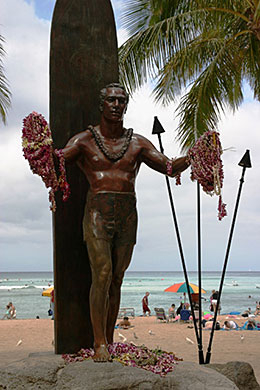
The Duke Kahanamoku statue on
Kuhio Beach in Waikiki is usually bedecked with leis.
Some of the world’s biggest rideable surf pounds ashore at Peahi (a.k.a. Jaws) on Maui. Duke Kahanamoku, a gold medal Olympic swimmer who passed away in 1968, is considered the Ambassador of Surfing for helping to revive and spread the sport. Belgium-born Father Damien, who tended the lepers at Kalaupapa on Molokai until his death from the disease, was canonized as Saint Damien in 2009.
Makauwahi Cave and sinkhole on Kauai’s south shore may be the richest fossil bed in all the Pacific. Rainwater carved through fossilized sand dunes revealing a 10,000-year treasure trove of geological, botanical and archaeological finds. Ka Lae on the Island of Hawaii is the southern-most tip of the United States.
#6 - ENDLESS ADVENTURE
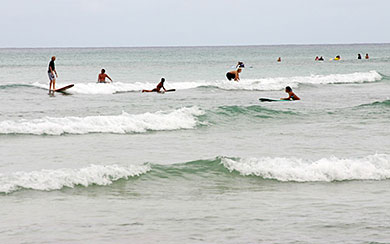 
Once a playground for Hawaiian alii (royalty), the tranquil waters of Waikiki Beach is perfect for neophyte surfers. Paddleboarders enjoy the Waimea River on Oahu’s North Shore. Every sort of imaginable water sport is possible
in Hawaii. Surf with board or kite or body, paddle board and parasail, sail or water ski, snorkel and scuba dive, surf
or deep-sea fish, watch the whales, swim with dolphins and sharks and turtles.

A successful wild boar hunt in Waimea Canyon, Kauai.
On many of the islands you can hunt pheasant and partridge
or larger game such as wild pig, goat and mouflon sheep.
`Hiking opportunities exist atop mountain ridges, along shorelines, through valleys and canyons, and across dormant volcanoes. Off-roading is another option to explore the backcountry. Nearly 100 films have made use of stunning Hawaiian locations and movie fans can enjoy various tours to places and adventures you’ve seen on the big screen.
 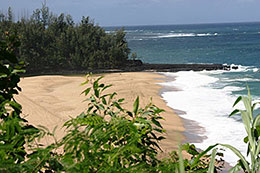 
Countless movies have been filmed on Kauai. An ancient fishing and farming village situated along the Wailua River,
Kamokila Village (left) has been reconstructed using traditional building techniques and was used as the African village
in the movie Outbreak. Lumahai Beach (center) is most famous for the scene in South Pacific where Mitzi Gaynor
“washed that man right out of” her hair, while Makana Peak was the stand-in for the movie’s “Bali Hi”.
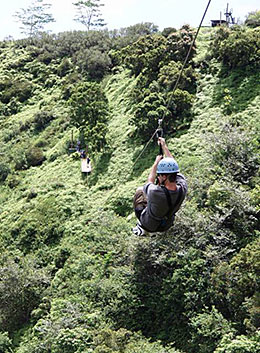 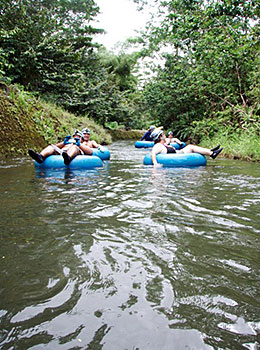 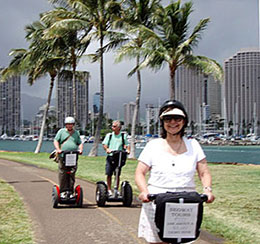
Ziplines weave down mountainsides, through rainforests and across streams. Innertube through sugarcane ditches or ride a
bicycle down the road at Waimea Canyon or Haleakala. Segway through Waikiki or a tropical botanical garden.
If you love to whack little dimpled balls across rolling expanses of grass, take advantage of more than 100 public
a
and private golf courses spread across all the visitable islands. And if you’re one of those hardier souls who needs to
sweat it out, sign up for triathlons and Iron Man competitions all over the islands.
#7 – ALOHA SPIRIT
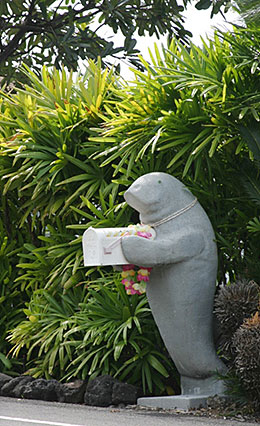
This smiling manatee greets the local mailman in Kona, the Island of Hawaii.
It’s not just a PR or marketing tagline. The warmth and welcome of Aloha envelopes you, leaving a joy and appreciation for life. You feel it in the kindness and humility of the people, the beauty and harmony of the land, and the patience and perseverance to deal with what life gives you. The Aloha Spirit is real, it is tangible, it is distinctive, and it permeates the Islands.
#8 – THE WEATHER
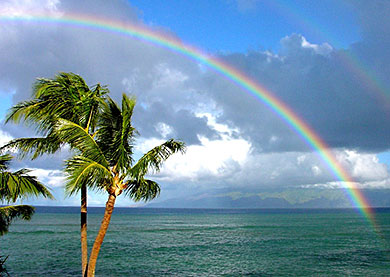 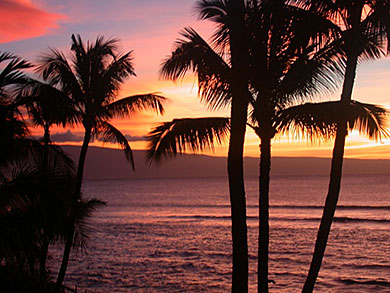
Although temperatures in Hawaii vary by elevation, they are fairly consistent year-round with about a ten degree
difference between day and night. Expect daytime temps in the mid-70s to mid-80s around sea level - greatly
influenced by the trade winds. But if you want variety, the Island of Hawaii boasts four of the world’s five major
climate zones plus 11 of the 13 climatic regions.
Generally the windward or east side of the islands receive more rainfall, which often occurs overnight, dampening the ground but not the spirit. Water temperature, hovering in the same ranges as the air, only varies about five degrees year round. The Island of Hawaii is at about the same latitude as Mexico City
#9 – IT’S UNCOMPLICATED
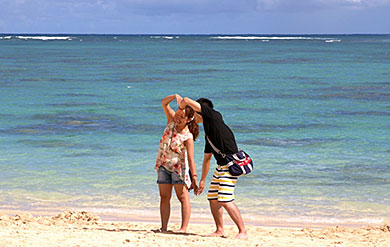 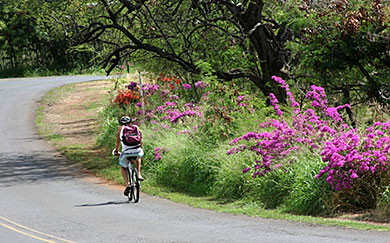
Young lovers frolic on Lanikai Beach, Oahu, and a bicyclist enjoys the Makaha Valley.
While Hawaii radiates an exotic ambiance, North Americans in particular will find it an easy transition. Just speak English and drive on the right side of the road. Americans don’t need a passport or to go through Customs, and no worries about converting U.S. currency or pesky foreign transaction fees.
Although Hawaiian words can seem intimidating, pronouncing them isn’t as difficult as it seems. Comprised of just 17 letters, vowels always have the same sound (no “long” or “short” variations), and you just take the time to pronounce each one. No “silent” letters. No “ch”-sounds-like-“k”-or-maybe-“s”-or-perhaps-“chuh”. Heck, if you can handle the silliness of English, you can tackle Hawaiian. (See Hawaiian Language Sidebar).
#10 – THE LEGENDS:

The Maniniholo Dry Cave on the north shore of Kauai
is said to have been one of Pele’s unsuccessful
attempts
to find a home for her volcanic fury.
Among Hawaii’s many legends and myths, the fire goddess Pele’s volcanic exploits reverberate across the Pacific. After creating much havoc in the South Pacific where she was born, Pele fled to Kauai looking for a place where her fires could blaze. She dug holes around Kauai, often leaving caves behind, but water kept putting out the fire. She lived in Haleakala for a while but eventually moved on to the Island of Hawaii, and now makes her home in the Halemaumau crater of Kilauea.
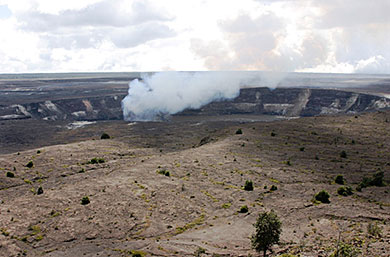 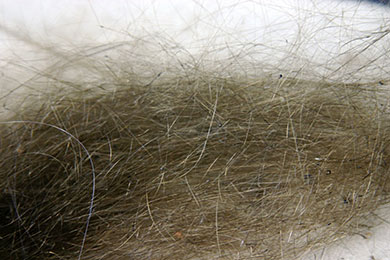
Pele finally settled down in the Halemaumau Crater (left), where believers often leave offerings to the Goddess of Fire and Volcanoes. When fountains of lava spring to life, molten rock is thrown into the air often creating fragile strands of volcanic glass called Pele’s Hair (right).
| |
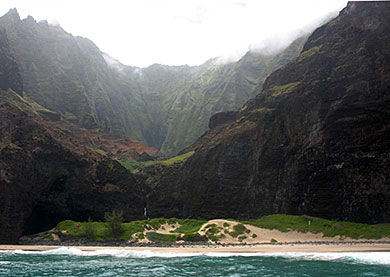 |
|
Frequently referred to as “Valley of the Lost Tribe,” the Honopu Valley on the Na Pali coast of Kauai was home to the Menehune. The white sand beach has seen a lot of activity on the big screen. This is the location where pirates bore down on Harrison Ford in Six Days, Seven Nights and Jessica Lange escaped in King Kong. The beach and its 90-foot rock arch have also appeared in Man with the Golden Gun, Pirates of the Caribbean: On Stranger Tides, Honeymoon in Vegas and Raiders of the Lost Ark. |
|
Known for their work ethic and mischievous ways, the Menehune were a race of small folks and the legendary original inhabitants of the islands. Credited with many building projects, their extraordinary feats were carried out only at night and either completed in one night or left forever unfinished. They were perhaps most industrious on Kauai, reputedly home to 500,000 of them when the Tahitians arrived. In an early 19th century census, 65 inhabitants of a valley west of Hanalei identified themselves as “menehune”.
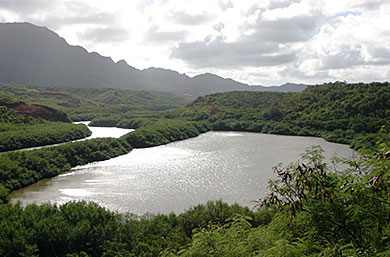 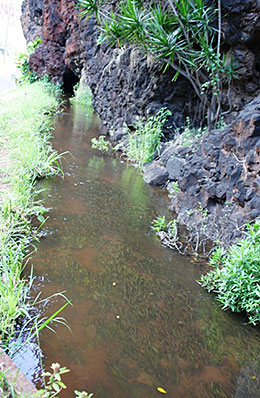
The Alekoko, a.k.a. Menehune Fishpond (left), was constructed on Kauai’s Huleia River near Lihue but left uncompleted because the sun came up before the massive engineering project could be completed. A 900-foot long wall separates
the
pond from the river, the masonry walls rising five feet above water level and in some places 30 feet beneath.
They did complete their Menehune Ditch (right) on the other side of the island near Waimea. This ancient aqueduct,
which once ran for 25 miles, carries water through chiseled stone tunnels and along canals lined with cut lava rock.
While Pele builds and destroys with explosive and blazing passion, and the Menehune are admired for their ingenious assemblages, the Night Marchers might be best known for the fright and chicken skin (goose bumps to Hawaiians) instilled in those who encounter them.
Appearing most often during the third quarter of the moon, these apparitions of ancient Hawaiian warriors have been seen for hundreds of years. In full battle regalia, they march along completely oblivious to startled viewers. Armed with polou (javelin-type weapons sometimes over 20 feet in length) and lei o mano (flat shark-tooth-edged clubs), accompanied by the sound of chanting and drums, their flickering torches have been seen weaving down hillsides, through valleys and across beaches.
 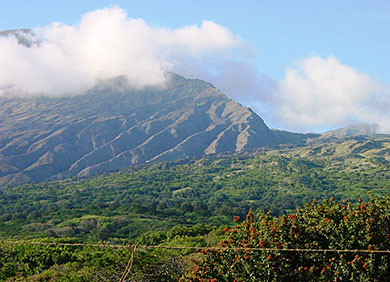
Sightings of Night Marchers have occurred at the Port Allen Airport, Kauai (left) and the Kaupo lava fields at the base of Haleakala, Maui (right). One homeowner on Molokai who lives in their paths, leaves his front and back doors open so they can pass through without bothering him.
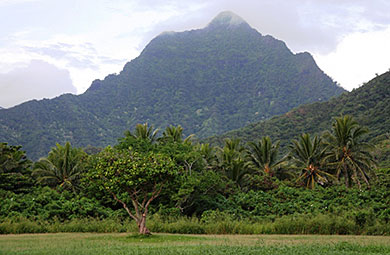 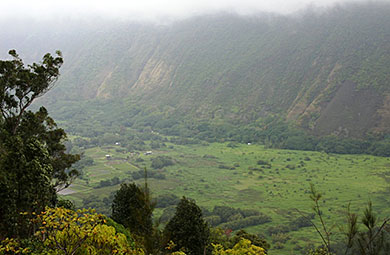
Night Marchers frequent Oahu’s Kualoa Valley (left), where they descend the hills and march up the beach.
The Waipio Valley on the Island of Hawaii (right) is famous for its ongoing occurrences.
The valley is also said to have been home to the Menehune.
There is an endless list of accolades and Best-Of’s acquired by the Hawaiian Islands. But what makes memories aren’t the awards, it’s the experiences. Now that you know WHY you should discover, or rediscover, the Islands of Hawaii, how to decide which one? Each is unique and provides a different ambiance and experiences, which I’ll cover in upcoming articles to help you choose.
SIDEBAR: European Discovery
Captain Cook is usually credited as the first European to “discover” Hawaii and much of the South Pacific. But, two hundred years earlier the Spanish ran trade routes between Mexico and the Philippines, and their navigational charts placed these islands at their correct latitude. The English obtained one of these maps during the capture of a Spanish galleon, and Cook had a copy of those charts with him during his expedition. When his crew reached Kauai, they found iron implements and weapons in a land that didn’t mine metal, a good indication that the English weren’t the first Europeans to arrive on these shores.
SIDEBAR: Hawaiian Language
When you look at written Hawaiian, you will see some unusual characters called diacritical markings. These markings change the meaning of words and also how they are spelled and pronounced. An upside-down apostrophe, called an okina or glottal stop, forces a small pause between vowels. A straight bar above a vowel is a kahakō or macron, and places emphasis on that vowel. Vowels are pronounced “A” = ah as in father, “E” = a as in vein, “I” = e as in be, “O” = o as in no, “U” = 00 as in mood. Consonants have the same sound as in English.
While many Hawaiian words, including Hawai’i, are properly spelled using these diacritical markings, this article does not include all of them because they cannot be properly deciphered by all computers or fonts. The islands are properly spelled Kaua’i, Ni’ihau, O’ahu, Lāna’i and the Island of Hawai’i.
Of Polynesian roots, you will hear Hawaiian (‘olelo Hawai’i) used in cultural and ceremonial settings. Its use was banned by the missionaries in 1820 and by the schools in 1896. But in 1978, local votes restored this as a second official language. State law now mandates proper spellings on streets signs.
Learning a few words can make your visit easier. Aloha (hello and good-bye) and mahalo (thank you) are the most basic. A few often-heard words to make you feel more of a local: pau (finished, done), pono (good, correct), keiki (child) and ohana (extended family). If someone wants to “talk story”, sit for a spell and listen while they shoot the breeze. And welcome to the world of Hawaiian Pidgin. If something is described as “broke da mouth” it tastes really good, and “da kine” means it’s the best. If asked why you gave “stink eye,” apologize for the unintentional dirty look.
|
|